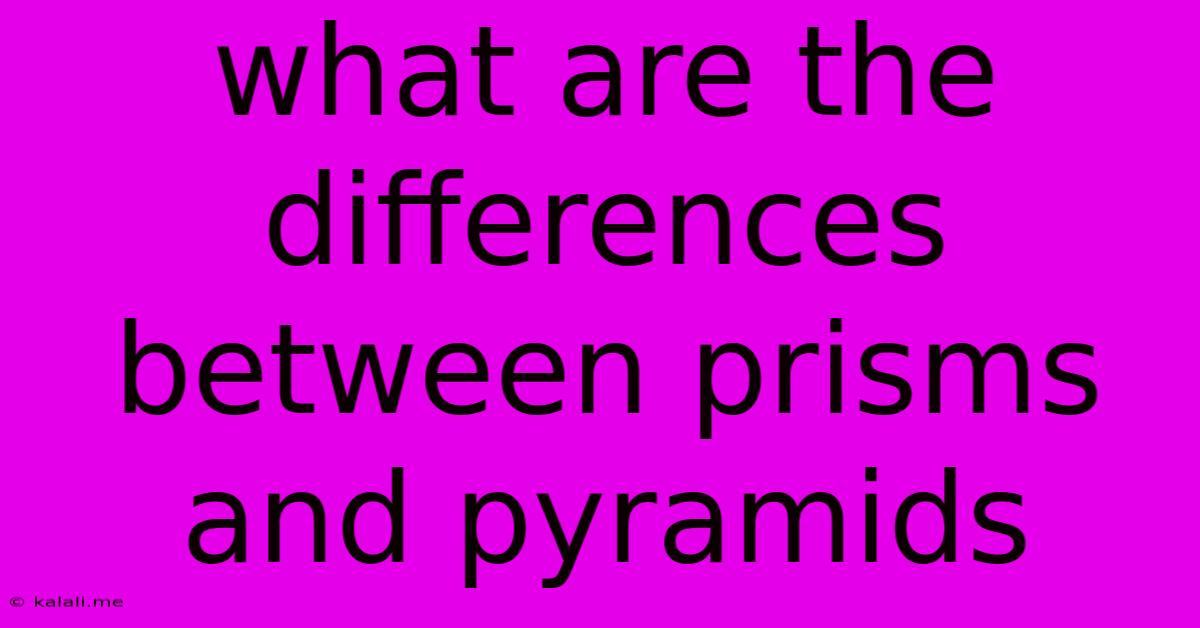What Are The Differences Between Prisms And Pyramids
Kalali
Jun 11, 2025 · 2 min read

Table of Contents
Prisms vs. Pyramids: Unveiling the Geometric Differences
Understanding the differences between prisms and pyramids is fundamental to grasping basic geometry. While both are three-dimensional shapes with polygonal bases, their structures and characteristics differ significantly. This article will delve into these key distinctions, clarifying the defining features of each shape and providing helpful examples to solidify your understanding. This will help you differentiate between prisms and pyramids, improving your understanding of solid geometry.
What is a Prism?
A prism is a three-dimensional solid that has two congruent and parallel polygonal bases connected by parallelogram faces. Imagine taking a polygon (like a triangle, square, or pentagon) and extending it straight up to create a solid. The resulting shape is a prism. Key characteristics include:
- Two congruent and parallel bases: These bases are identical in shape and size and are situated parallel to each other.
- Parallelogram lateral faces: The faces connecting the bases are parallelograms. In the case of a right prism, these lateral faces are rectangles.
- Consistent cross-section: If you slice a prism parallel to its bases, the resulting cross-section will always be congruent to the bases.
Types of Prisms: Prisms are categorized by the shape of their bases. Common examples include:
- Triangular prism: Bases are triangles.
- Rectangular prism (cuboid): Bases are rectangles.
- Pentagonal prism: Bases are pentagons.
- Hexagonal prism: Bases are hexagons.
What is a Pyramid?
A pyramid is a three-dimensional solid with a polygonal base and triangular lateral faces that meet at a single point called the apex or vertex. Unlike prisms, pyramids taper to a single point. Key characteristics include:
- One polygonal base: This is the only polygon that forms a complete face.
- Triangular lateral faces: All the other faces are triangles.
- Single apex: All the triangular faces converge at a single point above the base.
Types of Pyramids: Pyramids are also categorized by the shape of their base:
- Triangular pyramid (tetrahedron): Base is a triangle. This is a special case, as it's the only pyramid with all faces being triangles.
- Square pyramid: Base is a square.
- Pentagonal pyramid: Base is a pentagon.
- Hexagonal pyramid: Base is a hexagon.
Key Differences Summarized:
| Feature | Prism | Pyramid |
|---|---|---|
| Bases | Two congruent and parallel bases | One polygonal base |
| Lateral Faces | Parallelograms (rectangles in right prisms) | Triangles |
| Apex | No apex | Single apex (vertex) |
| Cross-section | Congruent to the bases | Changes shape as you move up the pyramid |
In Conclusion:
While both prisms and pyramids are polyhedrons (three-dimensional shapes with flat faces), understanding the key distinctions—the number and shape of their bases, the nature of their lateral faces, and the presence or absence of an apex—allows for accurate identification and analysis of these important geometric figures. Remember to focus on the number of bases and the shape of the lateral faces to quickly distinguish between these two fundamental 3D shapes.
Latest Posts
Latest Posts
-
E N I A C Stands For
Jun 12, 2025
-
What Was The First Word Processing Program Used In 1979
Jun 12, 2025
-
The Ends Of A Long Bone Are Called The
Jun 12, 2025
-
Which Planet Has The Fastest Revolution
Jun 12, 2025
-
Least Common Multiple Of 4 6 And 10
Jun 12, 2025
Related Post
Thank you for visiting our website which covers about What Are The Differences Between Prisms And Pyramids . We hope the information provided has been useful to you. Feel free to contact us if you have any questions or need further assistance. See you next time and don't miss to bookmark.